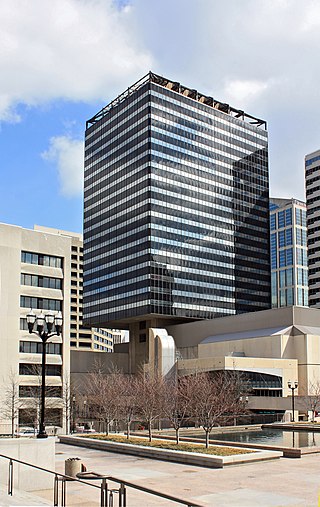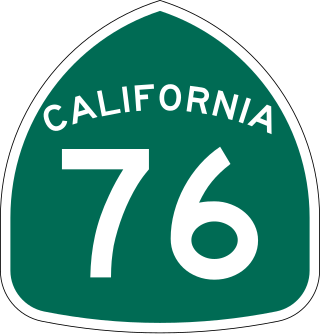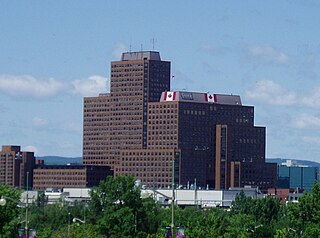
The California Department of Transportation (Caltrans) is an executive department of the U.S. state of California. The department is part of the cabinet-level California State Transportation Agency (CalSTA). Caltrans is headquartered in Sacramento.
The government of California is the governmental structure of the U.S. state of California as established by the California Constitution. California uses the separation of powers system to structure its government. It is composed of three branches: the executive, consisting of the governor of California and the other constitutionally elected and appointed officers and offices; the legislative, consisting of the California State Legislature, which includes the Assembly and the Senate; and the judicial, consisting of the Supreme Court of California and lower courts. There is also local government, consisting of counties, cities, special districts, and school districts, as well as government entities and offices that operate independently on a constitutional, statutory, or common law basis. The state also allows direct participation of the electorate by initiative, referendum, recall and ratification.
In the United States government, independent agencies are agencies that exist outside the federal executive departments and the Executive Office of the President. In a narrower sense, the term refers only to those independent agencies that, while considered part of the executive branch, have regulatory or rulemaking authority and are insulated from presidential control, usually because the president's power to dismiss the agency head or a member is limited.

The Orange County Transportation Authority (OCTA) is the transportation planning commission for Orange County, California in the Los Angeles metropolitan area. OCTA is responsible for funding and implementing transit and capital projects for the transportation system in the county, including freeway expansions, express lane management, bus and rail transit operation, and commuter rail funding and oversight.

The Georgia Department of Transportation (GDOT) is the organization in charge of developing and maintaining all state and federal roadways in the U.S. state of Georgia. In addition to highways, the department also has a limited role in developing public transportation and general aviation programs. GDOT is headquartered in downtown Atlanta and is part of the executive branch of state government.

State Route 52 (SR 52) is a state highway in San Diego County, California, that extends from La Jolla Parkway at Interstate 5 (I-5) in La Jolla, San Diego, to SR 67 in Santee. It is a freeway for its entire length and serves as a major east–west route through the northern part of the city of San Diego. The road connects the major north–south freeways of the county, including I-5, I-805, SR 163, I-15, SR 125, and SR 67. SR 52 passes north of the Rose Canyon Fault before traversing Marine Corps Air Station Miramar. East of Santo Road and west of SR 125, the highway goes through Mission Trails Regional Park, a large open preserve. SR 52 is also known as the Soledad Freeway and the San Clemente Canyon Freeway.

The Tennessee Department of Transportation (TDOT) is the department of transportation for the State of Tennessee, with multimodal responsibilities in roadways, aviation, public transit, waterways, and railroads. It was established in 1915 as the Tennessee Department of Highways and Public Works, and renamed the Tennessee Department of Transportation in 1972. The core agency mission of TDOT is to provide a safe and reliable transportation system for people, goods, and services that supports economic prosperity in Tennessee. Since 1998, TDOT has been ranked amongst the top five in the nation for quality highway infrastructure. It is primarily headquartered in downtown Nashville and operates four regional offices in Chattanooga, Jackson, Knoxville, and Nashville.

State Route 76 (SR 76) is a state highway 52.63 miles (84.70 km) long in the U.S. state of California. It is a much used east–west route in the North County region of San Diego County that begins in Oceanside near Interstate 5 (I-5) and continues east. The highway is a major route through the region, passing through the community of Bonsall and providing access to Fallbrook. East of the junction with I-15, SR 76 goes through Pala and Pauma Valley before terminating at SR 79.
The Metropolitan Transportation Commission (MTC) is the government agency responsible for regional transportation planning and financing in the San Francisco Bay Area. It was created in 1970 by the State of California, with support from the Bay Area Council, to coordinate transportation services in the Bay Area's nine counties: Alameda, Contra Costa, Marin, Napa, San Francisco, San Mateo, Santa Clara, Solano, and Sonoma. The MTC is fourth most populous metropolitan planning organization in the United States.
The Michigan Department of Transportation (MDOT) is a constitutional government principal department of the US state of Michigan. The primary purpose of MDOT is to maintain the Michigan State Trunkline Highway System which includes all Interstate, US and state highways in Michigan with the exception of the Mackinac Bridge. Other responsibilities that fall under MDOT's mandate include airports, shipping and rail in Michigan.
Regional Planning Councils (RPCs) are quasi-governmental organizations that are designated by Florida law (Ch. 186, Florida Statutes) to address problems and plan solutions that are of greater-than-local concern or scope, and are to be recognized by local governments as one of the means to provide input into state policy development. With regard to transportation-related issues, RPCs are empowered to provide technical assistance to local governments on growth management matters; coordinate land development and transportation policies in a manner that fosters region-wide transportation systems; review local government comprehensive plan amendments, evaluation/appraisal reports, and Developments of Regional Impacts for consistency with state and regional plans; and, review the plans of independent transportation authorities and metropolitan planning organizations to identify inconsistencies between those plans and applicable local government plans. RPCs are a type of Regional planning organization, specific to the state of Florida.

The Oklahoma Department of Transportation (ODOT) is an agency of the government of Oklahoma responsible for the construction and maintenance of the state's transportation infrastructure. Under the leadership of the Oklahoma secretary of transportation and ODOT executive director, the department maintains public infrastructure that includes highways and state-owned railroads and administers programs for county roads, city streets, public transit, passenger rail, waterways and active transportation. Along with the Oklahoma Turnpike Authority, the department is the primary infrastructure construction and maintenance agency of the State.
Executive Schedule is the system of salaries given to the highest-ranked appointed officials in the executive branch of the U.S. government. The president of the United States appoints individuals to these positions, most with the advice and consent of the United States Senate. They include members of the president's Cabinet, several top-ranking officials of each executive department, the directors of some of the more prominent departmental and independent agencies, and several members of the Executive Office of the President.
The South Carolina Department of Transportation (SCDOT) is a government agency in the US state of South Carolina. Its mission is to build and maintain roads and bridges and administer mass transit services.
The Hampton Roads Transportation Accountability Commission (HRTAC) is a political subdivision of the Commonwealth of Virginia in the United States that has the responsibility for funding several major traffic projects in the Hampton Roads area. It was created by the Virginia General Assembly in 2014 to maintain and administer the Hampton Roads Transportation Fund, a trust fund established by the Virginia General Assembly through a 0.7% increase in the state sales and use tax and a 2.1% increase in the fuel tax region-wide. The organization previously existed as the Hampton Roads Transportation Authority (HRTA) but was disbanded in 2008 after the Virginia Supreme Court invalidated its authority to raise and levy taxes.

The Canadian Transportation Agency is the independent, quasi-judicial tribunal of the Government of Canada that makes decisions relating to federally-regulated modes of transportation. Its headquarters are in the Jules Léger Building (South) in Terrasses de la Chaudière, Gatineau, Quebec.

The Mississippi Department of Transportation (MDOT) is the organization in charge of developing and maintaining all state and federal roadways in the U.S. state of Mississippi. In addition to highways, the department also has a limited role in supporting Mississippi's public transportation system, ports and waterways system, aeronautics and railroads. MDOT is headquartered in downtown Jackson.
The North Carolina Utilities Commission is a government agency that regulates the various utilities of the state of North Carolina. The Commission also regulates household goods transportation, buses, brokers and ferryboats.

The North Dakota Industrial Commission is the body that oversees the management of several separate programs and resources, including the Bank of North Dakota, North Dakota Mill and Elevator, and the Department of Mineral Resources. By law, it has three members: the Attorney General, the Agriculture Commissioner, and the Governor, who acts as chair.











